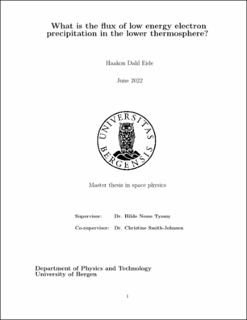| dc.description.abstract | The ionisation caused by Energetic particle precipitation (EPP) into the atmosphere, lead to chemical reactions producing NO_x (N, NO, NO_2) gases. Auroral electrons (1-30 keV) deposit their energy throughout the upper mesosphere and lower thermosphere. During the dark winter, the EPP-produced NO_x gases can survive for months and be transported down to the stratosphere, where it will destroy ozone through catalytic reactions. Studies comparing the NO density estimated by chemistry climate models and observations suggest that the estimation of NO-production by auroral forcing is overestimated during quiet times and underestimated during active time. This thesis provides an intercomparison of different auroral forcing estimates. We compare fluxes from the Total energy detector (TED) onboard the NOAA Polar Orbiting Environmental Satellites (POES) and Meteorological Operational satellite (MetOp) and sensor for precipitating particles (SSJ) from Defense Meteorological Spacecraft Program (DMSP). The data, taken over the year 2010, was sorted by the daily Kp and evaluated as function of geomagnetic latitude and magnetic local time. Discrepancies are evaluated in respect to geographical bias, potential spacecraft charging, as well as the detector's pointing directions relative to the magnetic field. Inside the auroral oval, for the dayside MLT sectors, the DMSP/SSJ instrument observed consistently higher electron fluxes than the POES/TED detectors, independent of Kp level. The shape of the energy flux spectra was evaluated in respect to Maxwellian, Exponential or Power law distributions. The best fit was shown to depend mostly on latitude, implying the magnetospheric origin of the electrons mainly decide the shape of the spectra. Furthermore, daily ionisation rate estimates implemented in the Whole Atmosphere Community Climate Model (WACCM) and estimated by the Atmospheric Ionization Module Osnabrück (AIMOS) were compared with the flux observations in mind. The data from the entire year of 2010, was estimated in WACCM's standard geographical grid and sorted by daily Kp level. Discrepancies were evaluated as functions of Kp, geographic latitude and longitude, with previous studies and our flux results as reference. WACCM underestimated the ionisation rate during periods of high geomagnetic activity, while overestimating during periods of weak activity compared to AIMOS. | |
